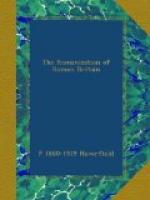Peace hardly set in till the opening of the third century. It was then, I think, that country-houses and farms first became common in all parts of the civilized area. The statistics of datable objects discovered in these buildings seem conclusive on this point. Except in Kent and the south-eastern region generally, not only coins, but also pottery of the first century are infrequent, and many sites have yielded nothing earlier than about A.D. 250. Despite the ill name that attaches to the third and fourth centuries, they were perhaps for Britain, as for parts of Gaul,[1] a period of progressive prosperity. Certainly, the number of British country-houses and farms inhabited during the years A.D. 280-350 must have been very large. Prosperity culminated, perhaps, in the Constantinian Age. Then, as Eumenius tells us, skilled artisans abounded in Britain far more than in Gaul, and were fetched from the island to build public and private edifices as far south as Autun.[2] Then also, and, indeed, as late as 360, British corn was largely exported to the Rhine Valley,[3] and British cloth earned a notice in the eastern Edict of Diocletian.[4] The province at that time was a prosperous and civilized region, where Latin speech and culture might be expected to prevail widely.
[Footnote 1: Mommsen, Roem. Gesch., v. 97, 106, and Ausonius, passim.]
[Footnote 2: Eumenius, Paneg. Constantio Caesari, 21 civitas Aeduorum ... plurimos quibus illae provinciae (Britain) redundabant accepit artifices, et nunc exstructione veterum domorum et refectione operum publicorum et templorum instauratione consurgit.]
[Footnote 3: Ammianus, xviii. 2,3, annona a Brittaniis sueta transferri; Zosimus, iii. 5.]
[Footnote 4: Edict. Diocl. xix. 36. Compare Eumenius, Paneg. Constantino Aug., 9 pecorum innumerabilis multitudo ... onusta velleribus, and Constantio Caesari, 11 tanto laeta munere pastionum. Traces of dyeing works have been discovered at Silchester (Archaeologia, liv. 460, &c.) and of fulling in rural dwellings at Chedworth in Gloucestershire, Darenth in Kent, and Titsey in Surrey (Fox, Archaeologia, lix. 207).]
No golden age lasts long. Before 350, probably in 343, Constans had to cross the Channel and repel the Picts and other assailants.[1] After 368 such aid was more often and more urgently required. Significantly enough, the lists of coins found in some country-houses close about 350-60, while others remained occupied till about 385 or even later. The rural districts, it is plain, began then to be no longer safe; some houses were burnt by marauding bands, and some abandoned by their owners.[2] Therewith came necessarily, as in many other provinces, a decline of Roman influences and a rise of barbarism. Men took the lead who were not polished and civilized Romans of Italy or of the provinces, but warriors




